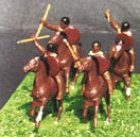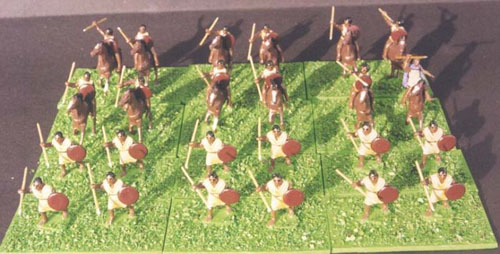Conversions forNumidian |
 |
Figures Used
|
The rider is based on the French Napoleonic Cuirassier. The cuirass becomes the tunic. Everything else is cut off or scraped off. Cut down the helmet so that it becomes the hair. Paint the cuirass area and the head with a coat of PVA white glue to smooth over defects. The dark skin colour hides the conversion work also.
The shield is a washer glued to the figure with super glue, the hole covered with a piece of paper from a hole punch and then given a coating of white PVA glue to smooth the surface out. Alternatively the shield could have been made from a small headed thumb tack.
The javelen is made from a pin cut to length.
Notes
- The shield is probably too large for the figure and a smaller sized washer should have been used.
- The chariot horses used have some sort of collar around their chest which I didn't cut away but rather relied on painting the horse a dark colour to camouflage it somewhat.
 |
Figures Used
|
Conversion
The hood at the back of the figure was cut away as was the bow. The javelin is a pin cut to size.
The shield is a washer glued to the figure with super glue, the hole covered with a piece of paper from a hole punch and then given a coating of white PVA glue to smooth the surface out. Alternatively the shield could have been made from a small headed thumb tack.
The tunic sleeves have been painted skin colour thereby making them part of the arm.
Notes
- The reference material shows the tunic as shorter and more bunched at the shoulder than is displayed on this conversion.
 |
Figures Used
|
Conversion
The Romans are cut in half as are the 7th Cavalry riders. The legs are then pinned and super glued to the Roman torso. The shields were added to the figures and glued in place. The javelin is a pin cut to size. Gaps at the torso join can be filled by painting the join area with PVA white glue. Indeed a coat of glue over the figure will help hold it together.
The Roman helmet was painted as gallic style helmet with neck guard painted as hair.
The rider's pants went into high boots. The pants were pained in a dark colour as breeches and the tops of the boots were pained flesh colour and the bottom as shoes.
Notes
- On a personal note these figures are the first conversions I ever undertook. They were done way back in 1972 as Roman cavalry. With new shields, moustaches and painting the back of the helmet as hair they have been recycled as Gauls.
- Airfix 7th Cavalry have long been out of production. However if you look at through the Napoleonic cavalry produced by Revell, Hat and Italeri you should find something that will suffice.
 |
Figures Used
|
Conversion
The figures are used straight out of the box with no conversion required other than painting the skin a dark colour.
Notes
- The Airfix Romans come from the Early Imperial period and can be used to represent the Roman style troops of Tacfarinas (circa 20 AD). It is probably an anachronism to use these figures with the elephants of the Republican period. Purist could instead use Romans legionaries from the Hat Punic War range.
Conversion
The blanket is made from heavy paper such as cartridge paper. Cut rectangles pieces of paper out and try them out on the elephant until one looks right. Then covered both sides with PVA glue until soaked and mould it onto elephant body and let it dry. When dry paint the elephant.
The howdah is constructed from cardboard (from an art supply shop) and is essentially an oblong box. The sizing was done by eye. It is constructed from 4 pieces which form the sides. Cut these out and glue them together. A channel was carved fore and aft into the underside of the box with a knife until it sat well on the elephant. The howdah was then glued into place.
Finally the painted crew and mahout were glued on.
Notes
- The elephants are the African forest elephants species which were smaller than Indian Elephants used in the East and stood 7-8 feet (2.15m - 2.45m) tall at the shoulder. In 20mm scale you want a model elephant about 25mm high at the shoulder.
- An alternative for the mahout is to bend the legs under the figure so it crouches on top rather than riders astride the elephant. You can do this by putting the figure in hot water, bending, then setting the legs in the new position in a container of cold water.
(To contact the author, click here.)
References
Barker, Phil. and Scott, Richard Bodley. DBM Army Lists, Book 2 and Book 3.
Barker, Phil. The Armies and Enemies of Imperial Rome, WRG
Head, Duncan. Armies of the Macedonian and Punic Wars, WRG
Warry, John. Warfare in the Classical World, Lansdowne Press, 1980.
The DBA Page Reference - An article on Numidan and Moorish DBA armies may be found here



